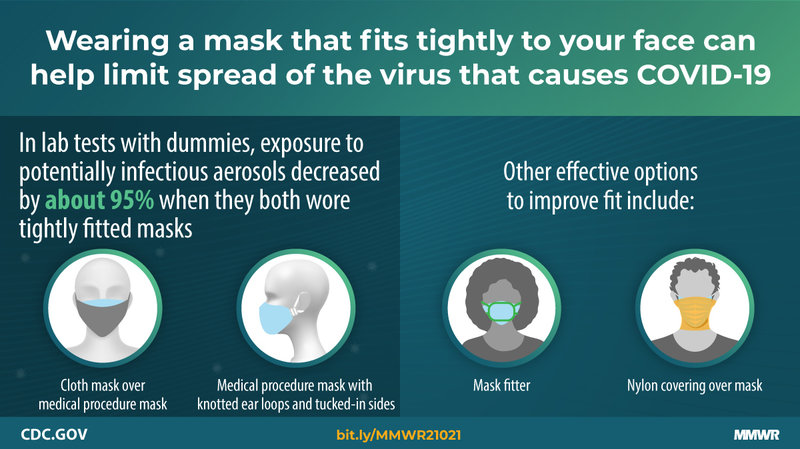
For the past year, health officials have been struggling to get Americans to wear a mask. Now those same officials may be facing pushback again from anti–maskers, as a recent research report released in early February by the CDC suggests that, to further slow the spread of COVID-19, Americans should begin to “double mask” or universal masking.
According to the research report, “Universal masking is recommended to slow the spread of COVID-19. Cloth masks and medical procedure masks substantially reduce exposure from infected wearers (source control) and reduce exposure of uninfected wearers (wearer exposure).”
CDC conducted experiments to assess two ways of improving the fit of medical procedure masks: fitting a cloth mask over a medical procedure mask or knotting the ear loops of a medical procedure mask and then tucking in and flattening the extra material close to the face. Each modification substantially improved source control and reduced wearer exposure.
These experiments highlight the importance of a good fit to maximize mask performance. There are multiple simple ways to achieve a better fit of masks to more effectively slow the spread of COVID-19.

Centers for Disease Control and Prevention
The report finds that double-masking or using more layers while wearing a mask decreased aerosol exposure by 95%. And for optimal protection, the CDC says to make sure the mask fits snugly against your face and to choose a mask with at least two layers.
“In the study, wearing any type of mask performed significantly better than not wearing a mask,” CDC Director Rochelle Walensky said in a briefing from the White House COVID-19 Response Team on Feb. 10. “… Well-fitting masks provided the greatest performance at both blocking emitted aerosols and exposure of aerosols to the receiver. In the breathing experiment, having both the source and the receiver wear masks modified to fit better reduced the receiver’s exposure by more than 95%, compared to no mask at all.”
The CDC’s guidance on improving mask fit now recommends:
- Choosing a mask with a nose wire, which prevents air from leaking out along the top
- Using a mask fitter or brace over a disposable or cloth mask to prevent air from leaking out. These small, reusable devices cinch a cloth or medical mask to create a tighter fit and improve mask performance, Walensky said.
- Making sure your mask fits snugly over your nose, mouth and chin: “If the mask has a good fit, you will feel warm air come through the front of the mask and may be able to see the mask material move in and out with each breath,” the CDC says.
- Adding layers of material — either by using a cloth mask with multiple layers of fabric or by wearing a disposable mask under a cloth mask.
But double-masking isn’t recommended for all masks. Don’t combine two disposable masks. The CDC says, “Disposable masks are not designed to fit tightly and wearing more than one will not improve fit.”
And don’t layer another mask on top of a KN95, as that mask should be used alone.
While health officials have been fighting the pushback from anti–maskers, as of Feb. 2, masks are now required “on planes, buses, trains, and other public transportation traveling into, within, or out of the U.S., as well as in U.S. transit hubs such as airports and stations.”
Walensky said the new laboratory findings highlight the importance of wearing a mask correctly and ensuring it fits properly over your nose and mouth. The information from the new report does not alter the CDC’s guidance on people aged 2+ to wear a mask in public and maintain social distancing.
